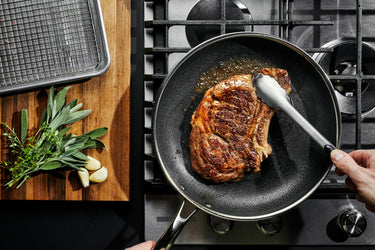Tagliata Steak: A Delicious Italian Steak Recipe

What You Need
Ingredients
Preparation
Tagliata di Carne
By Chef Daniele Uditi
Visit Daniele's Instagram for more recipe ideas: https://www.instagram.com/danieleuditi/
Instructions:
1. Start prepping the gremolata. In a medium mixing bowl bowl add roughly chopped parsley, chopped garlic, lemon zest, extra virgin olive oil, salt, pepper, and calabrian Chile paste. Mix together with a spoon and set aside
2. Slice cherry tomatoes in half. Place into a bowl and set aside .
3. Season steak with salt and pepper on both sides.
4. Add olive oil to a 10” HexClad Skillet and bring to medium-high heat.
5. For a 1.5 inch steak, cook for 3-4 minutes, flip, then reduce the heat on medium. Next, add garlic, parsley, and butter to the pan. Using a spoon, baste butter mixture over steak and cook for 1-2 more minutes.
7. Let steak rest for approximately four minutes before slicing
8. While the steak is resting, add cherry tomatoes back to the pan (utilizing the existing fat). Cook tomatoes in fat for 3-4 minutes.
9. To plate, place a layer of tomatoes down followed by sliced steak, a pinch of salt, a few spoonfuls of the gremolata, fresh arugula, and fresh shaved Parmigiano-Reggiano.
If you’ve been looking for a delicious, classic recipe to serve at your next family dinner party, you’ve come to the right place. Tagliata steak is a flavorful dish that you’ll want to make again and again. To help you get started, we have the perfect recipe from chef Daniele Uditi for his famous Tagliata di Carne.
What Is Tagliata di Carne?
Tagliata means “cut” in Italian and refers to the thin slices of steak that are the star of this dish. The typical cuts of meat used for this main course are boneless sirloin steak or flank steak.
Keep in mind that you’ll need a sharp knife for the precise cuts of this dish. We suggest our Damascus Steel 8” Chef’s Knife. The strong and sharp edge of Japanese steel is perfect for sliced steak. This blade is able to cut through that meat like butter.
What Makes Tagliata Steak Unique?
The name might refer to the way in which to serve the steak, but there’s another aspect to this dish that’s critical: the internal temp of the steak.
This dish is classically served as rare to medium-rare or with an internal temperature of 125 to 135 degrees Fahrenheit. It should be allowed to rest for four minutes after the searing and browning are done.
When you slice the steak, each piece should have a red center that’s slightly warm to the touch. The cooking time for this dish is quick. For a 1.5-inch-thick steak, you’ll want to cook it on high heat for three to four minutes on each side.
Is It Safe To Eat Rare Steak?
The short answer is yes, it’s safe. In fact, it’s healthier. Cooking meat to a med-well or well-done temperature will remove some of the iron as well as other nutrients that are found in the meat.
By eating the steak at lower internal temperatures, your food will still be safe from bacteria, and you will reap the full nutrient benefits of the protein.
Note: The minimal internal temperature or level of cookedness required for safe consumption differs depending upon the type of meat.
How Do You Serve Tagliata di Carne?
You can serve the tagliata however you prefer, but there are some traditional elements that really bring out the delicious flavors of this special dish.
Classically, beef tagliata will be served over a bed of cherry tomatoes that have been rendered in the fat of the meat for a couple of minutes while the steak is resting. You can also expect recipes calling for arugula mixed with a little extra virgin olive oil, some sea salt, crushed garlic cloves, and shaved Parmigiano-Reggiano.
For presentation points, you can also serve it on a cutting board surrounded by fresh rosemary sprigs with shavings of cheese and a drizzle of lemon juice or balsamic vinegar on top.
What Is the Best Pan for Making Tagliata Steak?
Traditionally, a cast iron skillet is the way to cook meat perfectly for steak tagliata. However, cast iron takes a lifetime to preheat and can still have cold pockets that won’t sear the meat evenly.
Instead, we recommend our 10” HexClad Hybrid Pan. It has the power of a cast iron skillet but features a stay-cool handle, is lightweight, and can stand up to the dishwasher to make clean-up a snap. The dish is simple enough, so don’t make the cooking process harder than it has to be.








